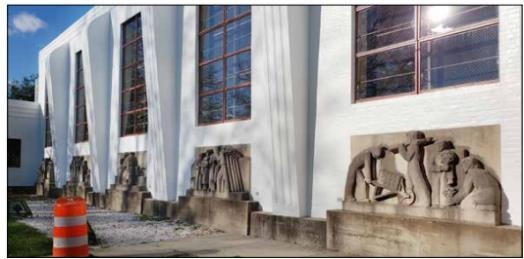The Community Center gymnasium windows have been renovated for several weeks now, and the recent uncovering of the bas-relief sculptures symbolizes completion of the windows project. Early this year, the city received a grant of $29,500 from the Maryland Heritage Areas Authority (MHAA). Public Works and the Planning and Community Development Department allocated the funds to revitalizing the bas-relief sculptures, which visualize phrases from the preamble to the U.S. Constitution, as well as the nearby marble garden statue and the Mother and Child statue at Roosevelt Center. When the revitalization of the sculptures was due to begin, those in charge of the project realized that the Community Center gymnasium’s rusted windows were what was causing the basrelief sculptures to get dirty. “The window frames were rusting out, which caused rust and black to drip down onto the sculptures, so we decided to fix the frames first. We thought it would be simple, but then it became more involved because the glazing compound contained asbestos,” said Brian Kim, assistant director of Public Works.
What began as a simple plan to clean the sculptures became a long project to fix problems that the city did not previously know existed. The window renovation began on July 13 and was just recently completed. When the window project started, the bas-relief sculptures were covered with specially made plywood boxes to protect them, and now that the project has been completed, they have been uncovered. According to Community Planner Molly Porter, the next step is to revitalize the basrelief sculptures, but she said they currently do not know when that aspect of the project will begin. MHAA grants are periodically given to nonprofit organizations and government entities for projects within a Certified Heritage Area. These grants are specifically for projects involving historical, cultural or natural resources, sites or events. In the case of Greenbelt, the grant was allocated to restore the bas-relief sculptures that have been a part of Greenbelt since its founding. The revitalization of the sculptures, despite being postponed until a later time, is a very important project for Greenbelt residents. “They give us sort of visual symbolism for many of the ideals under which Greenbelt was founded and which are still held dear today,” said Megan Searing Young, director of the Greenbelt Museum.
When Greenbelt was being founded, Lenore Thomas Straus applied and was chosen to do several sculptures here. Straus constructed six sculptures embodying the ideals of the preamble, though she proposed a seventh, a lynching scene with a judge and jury looking in the opposite direction. Those in charge of the project rejected this piece. “I think it’s one of the most important aspects of her story … that she was so involved with social justice,” Young said. The bas-relief sculptures ornament what was then Center School, Greenbelt’s elementary school; when a new elementary school was built in 1991, the building became the Community Center. Though it may take some time for the bas-relief sculptures to finally get cleaned as the grant initially intended, it is certainly upcoming and something that Greenbelt residents will notice. “If we didn’t address what was making the reliefs dirty, then they would just have to be cleaned again in a year,” said Kim.

